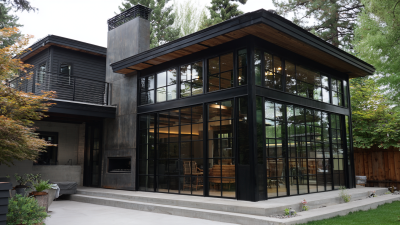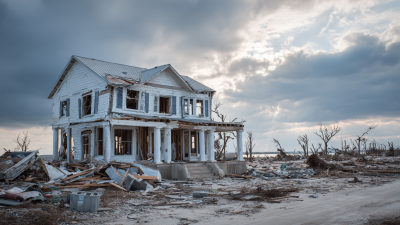As architectural trends continue to evolve, the demand for unique and functional designs has grown significantly, particularly in the realm of transom windows. A recent report by the Window & Door Manufacturers Association indicates that the market for innovative window solutions is projected to grow at a compounded annual growth rate (CAGR) of 5.2% through 2025, emphasizing the increasing popularity of transom windows in residential and commercial applications. These windows not only enhance aesthetic appeal but also contribute to energy efficiency and natural light optimization, making them a sought-after feature in modern design.

In this blog, we will delve into the future of transom window designs, comparing various styles and materials that cater to a diverse array of architectural needs and preferences, while highlighting the advancements in technology that are shaping this distinctive element of contemporary architecture.
Transom windows, a distinctive architectural element, have evolved significantly throughout history, reflecting cultural and design trends. Originally used to provide light and ventilation above doors, their design has transformed from simple, functional structures to elaborate features that enhance a building's overall aesthetic. In many historic districts, transom windows serve as a vital connection to the past, providing insight into architectural styles and the craftsmanship of bygone eras.
Recent developments in historic renovations, such as the updated design compliance of a downtown property in Winchester, illustrate the ongoing relevance of transom windows in modern architecture. Homeowners are now tasked with finding ways to honor the historical significance of their properties while also adhering to contemporary design guidelines. The evolution of transom windows from mere functional elements to essential features of historic restoration showcases how these designs marry utility with artistic expression, ensuring their survival in the dynamic landscape of architectural design. This blend of history and innovation continues to inspire modern interpretations that resonate with both the past and the present.
The modern aesthetic of innovative transom window designs is redefining interior and exterior spaces, merging functionality with striking visuals. According to a recent report by the American Institute of Architects (AIA), natural light has become a top priority in new residential designs, with 63% of architects stating that clients increasingly demand features that enhance daylighting. Transom windows, often positioned above doorways or larger windows, are uniquely suited to fulfill this desire, allowing for increased light penetration while maintaining privacy.
Additionally, a study published in the Journal of Architectural and Planning Research found that homes equipped with larger windows, including transom designs, can reduce energy consumption for artificial lighting by up to 30%. This not only contributes to sustainability but also elevates the overall aesthetic appeal of a space. The sleek lines and customizable shapes of modern transom windows can complement various architectural styles, making them a versatile choice for homeowners looking to enhance their interiors while embracing innovative design trends. As these windows become more prevalent, they continue to transform the ambiance of spaces, offering a perfect blend of style and utility.

Transom windows, known for their elegant design and ability to enhance natural light, often come with unique implementation challenges. One common issue is structural compatibility. Many older buildings may not have the necessary support for additional window installations. To address this, architects and builders can use engineered beams or brackets to redistribute weight and ensure the stability of the structure while accommodating the new design.

Another significant challenge is the integration of transom windows with existing HVAC systems. Improper placement can lead to inefficiencies in heating and cooling. Designers can overcome this by strategically positioning windows to maximize natural ventilation while maintaining climate control. Utilizing modern materials that offer better insulation properties can further enhance performance, making transom windows a viable option even in demanding climates. By confronting these challenges with innovative solutions, transom windows can continue to evolve and find their place in contemporary architecture.
As the architectural landscape evolves, the demand for innovative transom window designs grows, leading to the adoption of sustainable materials and technologies in their production. Recent reports indicate that the global green building materials market is expected to reach $600 billion by 2027, with sustainable windows comprising a significant segment of this growth. Among the materials, reclaimed wood, recycled glass, and energy-efficient insulation technologies are gaining popularity due to their minimal environmental impact and high performance.
Incorporating advanced manufacturing techniques, such as 3D printing and laser cutting, further enhances the capability to create bespoke transom window designs while reducing waste. A study from the National Renewable Energy Laboratory reveals that implementing energy-efficient window designs can reduce household energy costs by up to 25%, highlighting the importance of sustainable choices. As architects and builders increasingly emphasize eco-friendly solutions, transom windows made from sustainable materials will not only enhance aesthetic appeal but also contribute to a more sustainable future in construction.
| Design Aspect | Material Used | Sustainability Rating | Innovation Technology | Applications |
|---|---|---|---|---|
| Modern Aesthetic | Recycled Aluminum | A+ | Smart Glazing Technology | Residential, Commercial |
| Classic Style | FSC Certified Wood | A | Thermal Break Technology | Historic Renovations |
| Minimalist | Laminated Glass | A+ | Low-E Coatings | Modern Homes, Offices |
| Victorian | Reclaimed Wood | B+ | Triple Glazing | Renovation Projects |
| Contemporary | Composite Frames | A | Integrated Sun Shading | Eco-Friendly Buildings |
The transom window market is poised for significant innovation, driven by evolving architectural trends and advances in technology. According to a recent report by the Glass Association, the demand for energy-efficient windows, including transom designs, is expected to grow by 25% over the next five years. This shift emphasizes the importance of materials that enhance thermal performance while maintaining aesthetic appeal.
Future designs will likely incorporate smart glass technology, allowing homeowners to control light transmission and maximize energy savings. A study by the National Institute of Building Sciences suggests that integrating smart windows can reduce energy consumption in residential buildings by up to 34%. Furthermore, with the rise of sustainable building practices, architects are increasingly looking for transom window solutions that utilize eco-friendly materials and construction methods, aligning with the global push towards green building certifications like LEED.
As demand for customization increases, manufacturers are also expected to offer a wider array of sizes, shapes, and finishes for transom windows. A recent industry survey indicated that 70% of homeowners prioritize personalized design options when selecting windows for their homes. This trend will likely lead to more innovative products that cater to individual preferences while enhancing the overall architectural integrity of modern homes.







© 2025 RWC. All Rights Reserved. | Privacy Policy | Contractor’s License Number: 13VH00710200 | Sitemap | Areas Served
